If you own any of the stunning Calathea plant varieties and grow it successfully you will already know most of what the Medallion requires. Since Calathea medallion care is very much like all the other Calatheas.
For those of you who succumbed to an impulse buy and have never cared for one of these beauties…Read this care guide carefully and follow it.
The medallion is one of the rose painted Calatheas. Calathea Roseoptica Medallion is just one of the most gorgeous plants to grace my home.
The leaves are large and round with fascinating exotic patterns on the leaf top. Deep purple rose coloring on the leaf undersides provides contrast. Quite a showy combination.
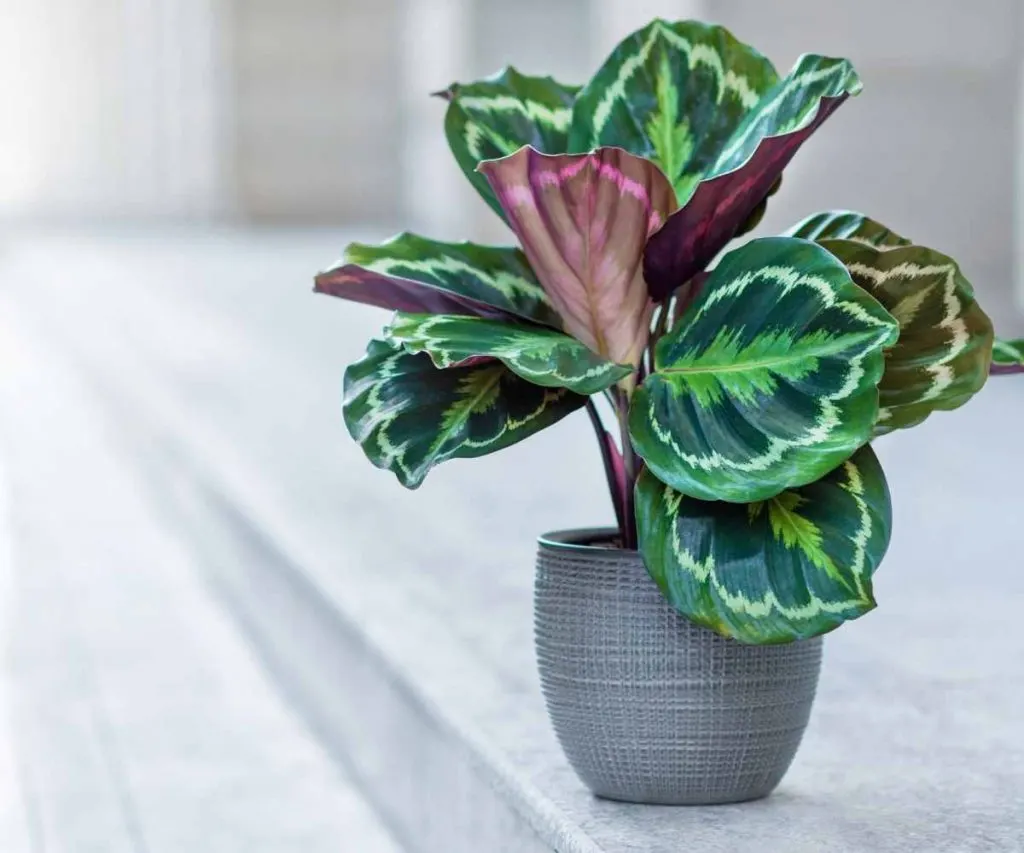
As a focal point in your home The medallion would work great in a minimalist decor with a boho feel. If you can give it the proper conditions it will provide you with years of beautiful eye catching life.
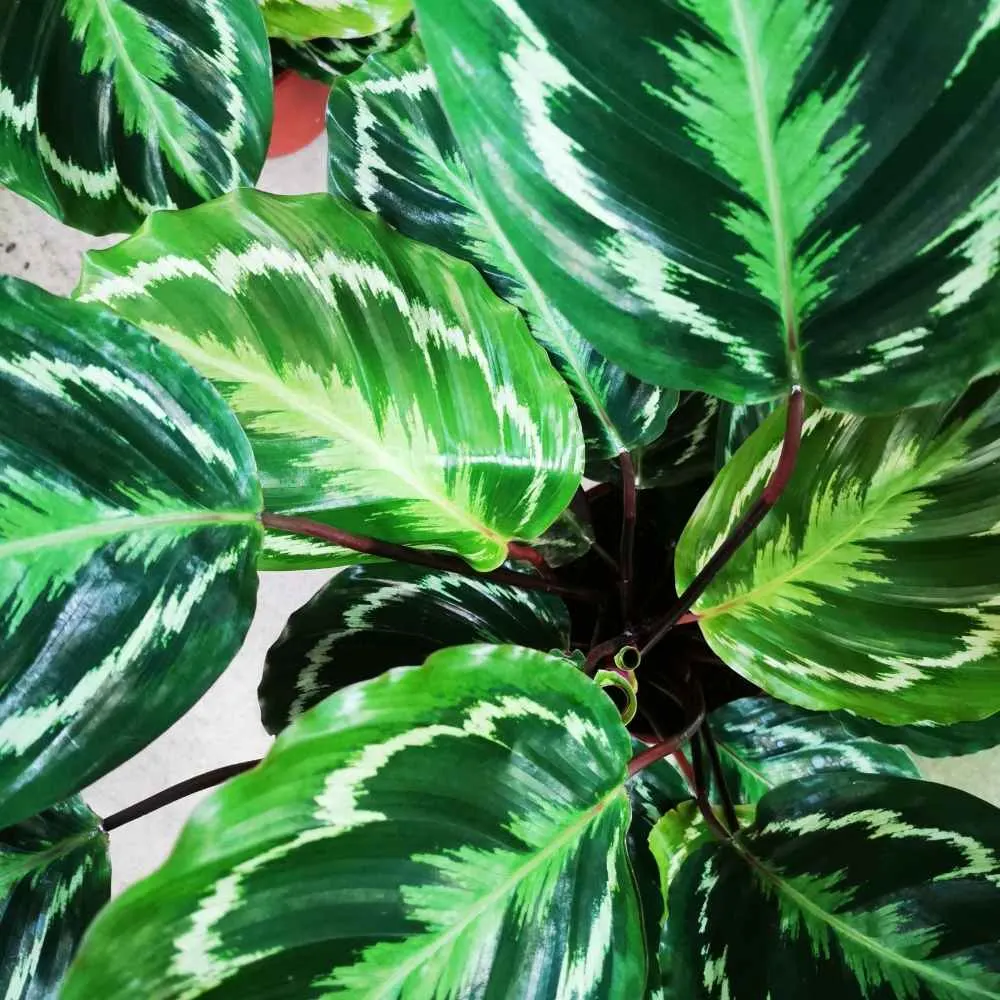
This is a plant native to the tropical rain forests of Ecuador in South America. The Medallion Calathea is part of the prayer plant family Maranataceae. Recently it has been reclassified. It’s botanical name is now Goeppertia veitchiana.
But we all know it as Calathea Medallion, Calathea roseoptica Medallion or Calathea veitchiana. That is most likely how it will be labeled in the garden shops.
Non Toxic and Air Filtering Plant:
This is a non toxic plant to both humans and pets. But keep them out of it anyway. You never know what pathogens or fungi are in the soil. Or what the leaves have absorbed over time with fertilizers. Or what may be living on the plant.
All calatheas also filter the air somewhat and produce oxygen. So they improve your living conditions and home health.
Calathea Medallion Growth and Habits:
The medallion Calathea grows as a bush upright two to three feet high. It will grow wider as the rhizomes multiply and eventually when you repot this plant you can propagate more by division.
As you see pictured below, the Medallion plants new leaves come up from the rhizome tightly rolled. As the leaves grow they unfurl into flat leaves on the ends of dark stems.
The leaves of the prayer plants fold up at night. They literally go from open and layered horizontally to catch the light to fold vertically in some fashion. Interesting to watch!
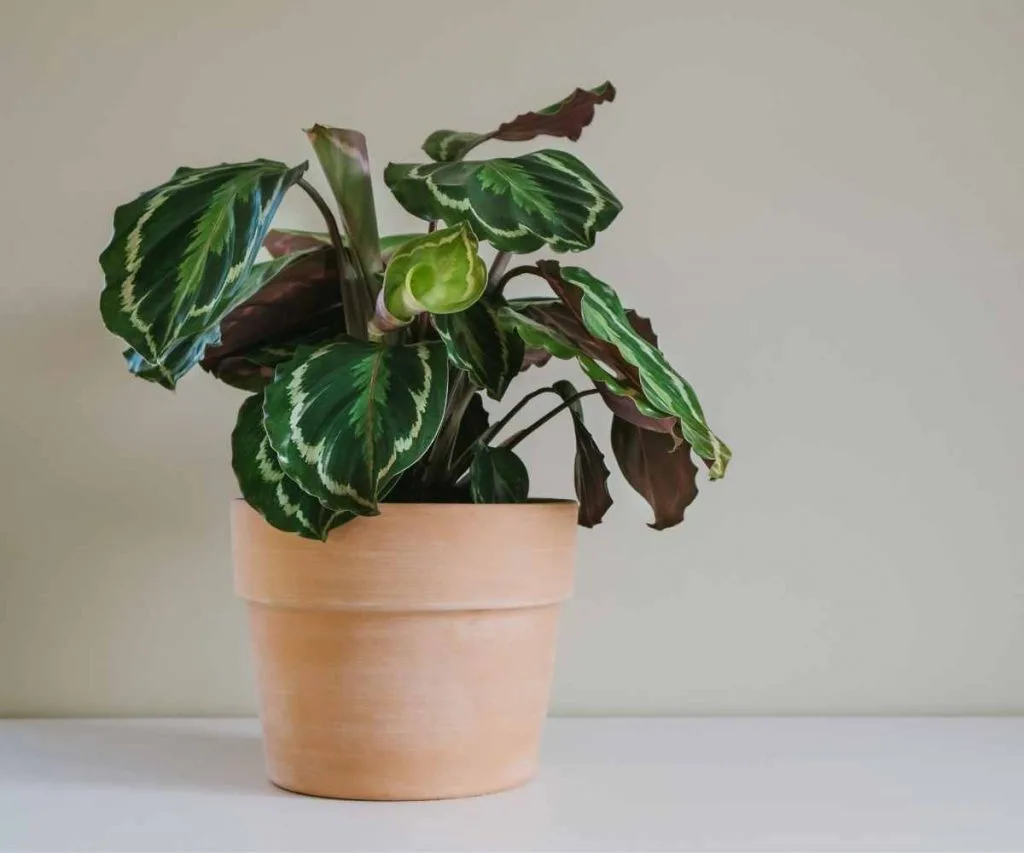
Calathea Medallion Care Tips:
Here is a quick summary of the most important tips to keeping your medallion happy. Medallions and all Calatheas require an extra dose of TLC.
- Keep the soil well draining.
- Water weekly and keep the soil evenly moist. NOT drenched or extremely dry.
- Use only distilled water. Possibly rain water will work. Tap water will cause brown crisping leaf edges.
- Use a hygrometer to make sure the humidity levels fall between 50% to 70 %.
- Set in the brightest north or east facing window and never give direct light. If the leaves begin to fade move further away from the light.
- They don’t like drafty areas. Keep them away from open windows and entry way doors.
- The best temperature for Medallions is 65 to 75 degrees F. They will tolerate some higher and lower but keep the humidity up.
Our printable care guide at the bottom of this post goes into all the details of care to keep the Calathea Medallion happy and in good health. Please practice these care tips. The calatheas are very sensitive.
I nearly killed my first Calathia oranata by treating it like all my other plants.
Your Medallion will be amazing if you care for it properly. If you don’t it will become a temperamental Diva with crispy brown leaves. It may fade, droop or get root rot and die.
If you see stress signs on your plant act quickly. it’s most likely a problem with the watering and humidity. Check these things first.
Calathea Medallion Care Guide
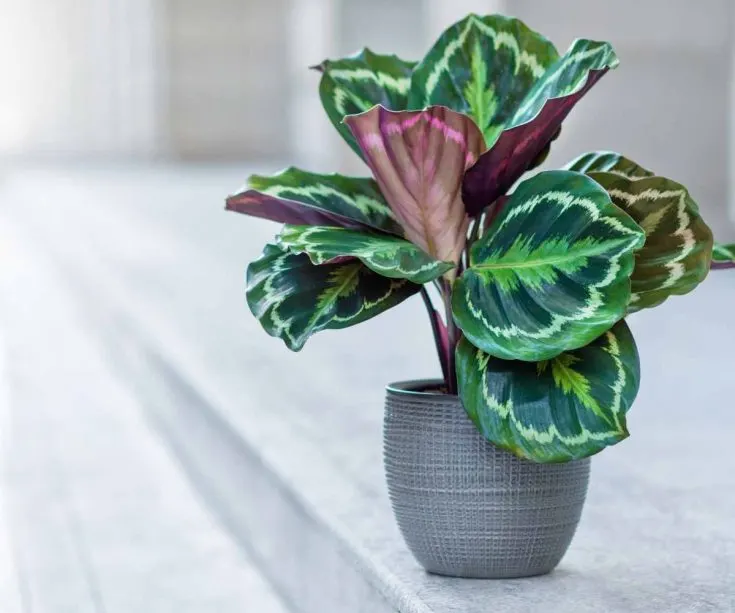
Calatheas Roseoptica Medallion are beautiful, exotic plants with wide appeal. Their care needs are specific and important. They are sensitive. .
Once you find the perfect growing conditions for your calathea it will perform well for you.
Learn what they need and give it to them. Their lovely foliage (in some cases they even flower) are so worth the effort!
All Calathea plant care is similar. No matter what type you own this care guide will apply.
Materials
Instructions
Soil Preference:
- Calathea Medallions enjoy a light well draining soil.
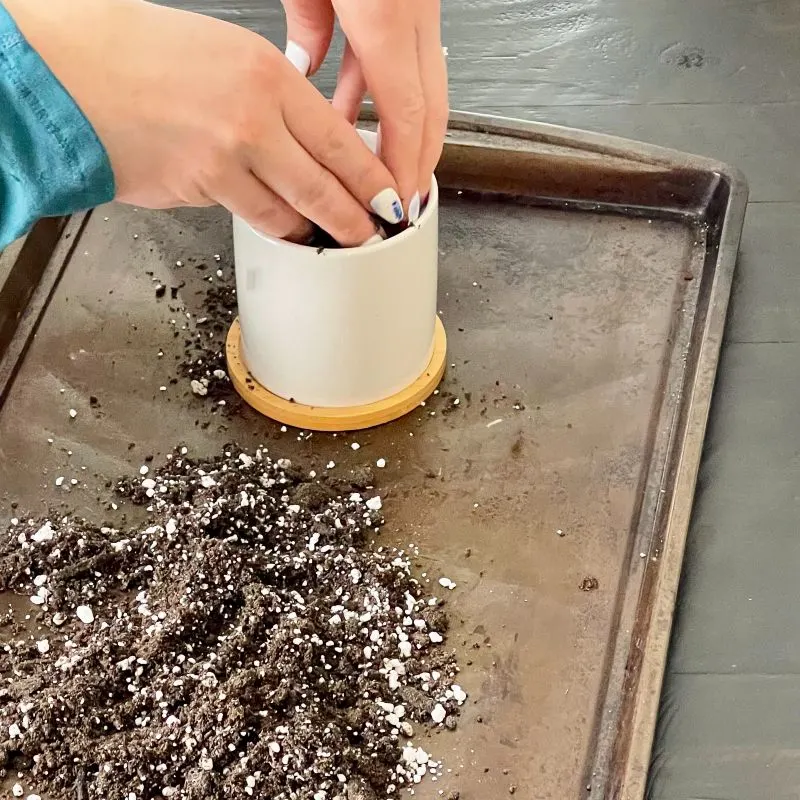
- A mix of potting soil and perlite will keep the roots happiest.
- Our mix for this plant is 70 % potting mix to 30% perlite.
- A heavy soil potting mix is not recommended for these plants.
Pot Size and Type: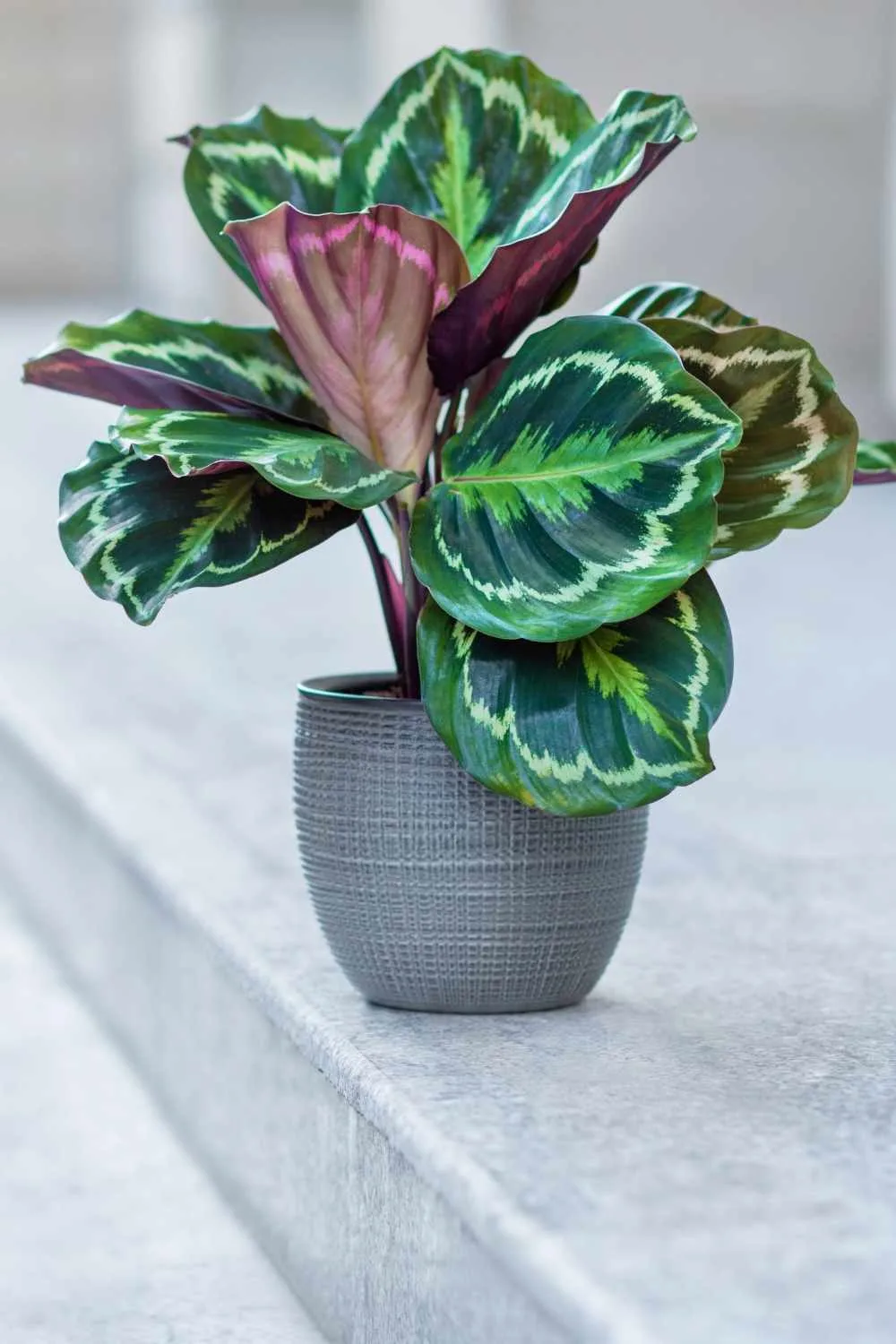
- Calatheas grow from rhizomes. And they grow new offshoots to the sides of the mother plant.
- This means they will fill a pot out as a wider plant eventually. Quite a nice table top centerpiece.
- Some of them can trail and be used for a hanging plant as they grow.
- Calathea Medallion has an upright bushy growth pattern. It will grow to the size of its pot. If you leave it to grow as a grouping in one pot you will need to find a pot that is shallower and has a wider circumference. They do not like to be overly root bound.
- If you want to encourage faster growth choose a pot about 2 inches wider in diameter than the current pot.
- Any well drained pot can be used. It MUST have excellent drainage.
- Terra cotta pots are not recommended. They will wick too much water away from the soil.
- Repot every second year or when roots come out the drainage holes on the pot bottom To the next pot size up.
- Don't jump to a huge pot from a small one unless you wish to encourage faster growth. Just go to the next size up pot.
- For Calatheas self watering pot systems work well. (linked above). They control the watering for you and help avoid root rot, overwatering and under watering.
- Calatheas enjoy evenly moist soil so self watering systems help here.
Lighting:
- Calatheas all enjoy indirect moderate light for best leaf variegation and optimal growth.
- Different species are fussier than others but as a general rule if the leaves fade move to a less bright area and see if that helps. Too much light can fade the leaves and crisp the leaf edge.
- It will tolerate lower indirect light but the plant may grow more slowly. Leaf variegations may not be well expressed.
- Shield this plant from strong direct light in summer south and west sunny windows. The leaves will burn and the colors will fade. Look for dry brown spots on the leaves and curling brown edges. If you see them move the plant to lower light.
- Tip: Window sheers or blinds can offset some brief periods of high direct light.
Watering:
- Calatheas are sensitive to the TYPE of water you use. These are plants accustomed to soft acid water from rain forests. Hard water high in minerals and salts may cause trouble for them.
- Let your tap water sit for 24 hours to allow any chemicals to dissipate. Filtered or distilled water will also prevent problems with minerals.
- Water your Calathea when the soil is dry down an inch or so. Calatheas enjoy even moisture in the soil. But never let it sit in soaking wet potting mix.
- If your calathea leaves start to roll up and curl, the plant droops or the edges turn brown suspect watering problems.
- Under watering can show all the symptoms listed above. Adjust your watering or soil mix to accommodate.
- Over watering will end in root rot, grey mold on the leaves, algae growth on the soil and fungus gnats or other pests moving in.
- Try a watering schedule of once a week. But do not water if the soil is wet. Alternately, Do not let the soil dry out completely.
- Watering is best done on a regular schedule so the plant is not over or under watered. Both can cause stress.
- These tropical plant enjoy humidity of 40 to 60%. That's a lot.
- In dry climates this plant will thrive with a humidifier nearby. Or set it in your kitchen or bathroom. Frequent misting on a regular daily schedule will help.
- More humidity tricks: Set the plant on a pebble tray with water not touching the soil for added humidity as necessary. Grouping plants together will provide more humid conditions.
- In dormant winter months reduce watering to when the soil is dry down 2 inches .
- Never let this plant get wet feet. If the soil is compacted the bottom of the soil can remain wet which encourages, grey mold on the leaves, root rot and Fungus Gnats. If you see yellow leaves or brown curling leaf edges you are probably overwatering or Inconsistently watering.
- self watering planters are a good choice for calatheas. They remove many of the watering problems listed here.
How to Fertilize:
- Calathea Medallions require a regular fertilizing schedule.
- Apply a good quality fertilizer (linked in materials) monthly through Spring and summer.
- Decrease feedings by late Fall and allow your Calathea plant to rest through the winter months.
- Look for brown spots on the leaves of your plants. This may indicate an over concentration of salts in the roots from over feeding. It can burn the leaves.
- The remedy is to set the plant under a faucet of water and let the water run through for 10 minutes or so. Allow the pot to Completely drain. Discontinue fertilizer until the plant recovers.
Temperature:
- Optimal temperatures for Calatheas are 65 degrees F. to 75 degrees F.
- Calatheas are sensitive to cold drafts from windows and doors.
- In winter, beware heat vents blowing on your plant leaves. Calatheas cannot tolerate uneven heating, or drying heat vents or drafts.
Pruning and Training:
- Sharp Hand pruners are preferred for pruning. They will give a clean cut that will heal quickly.
- Cut off the leaves of Calatheas at the soil line.
- Pruning is usually done to shape the plant or keep it small.
- Calatheas grow wider rather than taller. This makes them ideal table top or window sill plants.
Leaf Care:
- For the best care leaves enjoy occasional washing.
- This helps keep the stomata (leaf pores) open for plant respiration.
- Healthy leaves with a good clean surface are most able to resist pests.
- Dusty leaves will starve the plants of water exchange through humidity.
- Hand Wash the leaves monthly with water.
- You can also use a shower to clean off a calathea. Beware the water temperature. Keep it room temperature to avoid shocking the plant.
Pests:
- All plants get attacked by pests. Calatheas are especially susceptible to spider mites.
- Stress by longterm poor watering practices, poor light, extreme temperatures and soil conditions are contributors to pests. Fungus gnats will set up house in the soggy soil of an overwatered plant.
- Washing the plant leaves occasionally will help keep pests from establishing themselves on the plant.
- Spider mites are the biggest problem for Calathea plants. Watch for the webs. Treat immediately and continue for two weeks or more to remove the next generation of spider mites after the adults die. Eggs attach to the leaves and cannot be washed off easily.
- Mealy bugs, scale, thrips and whitefly are also common houseplant pests you will see in a stressed Calathea.
- Read our post on How to get rid of aphids and other pests with our homemade pesticide soap recipe or neems oil.
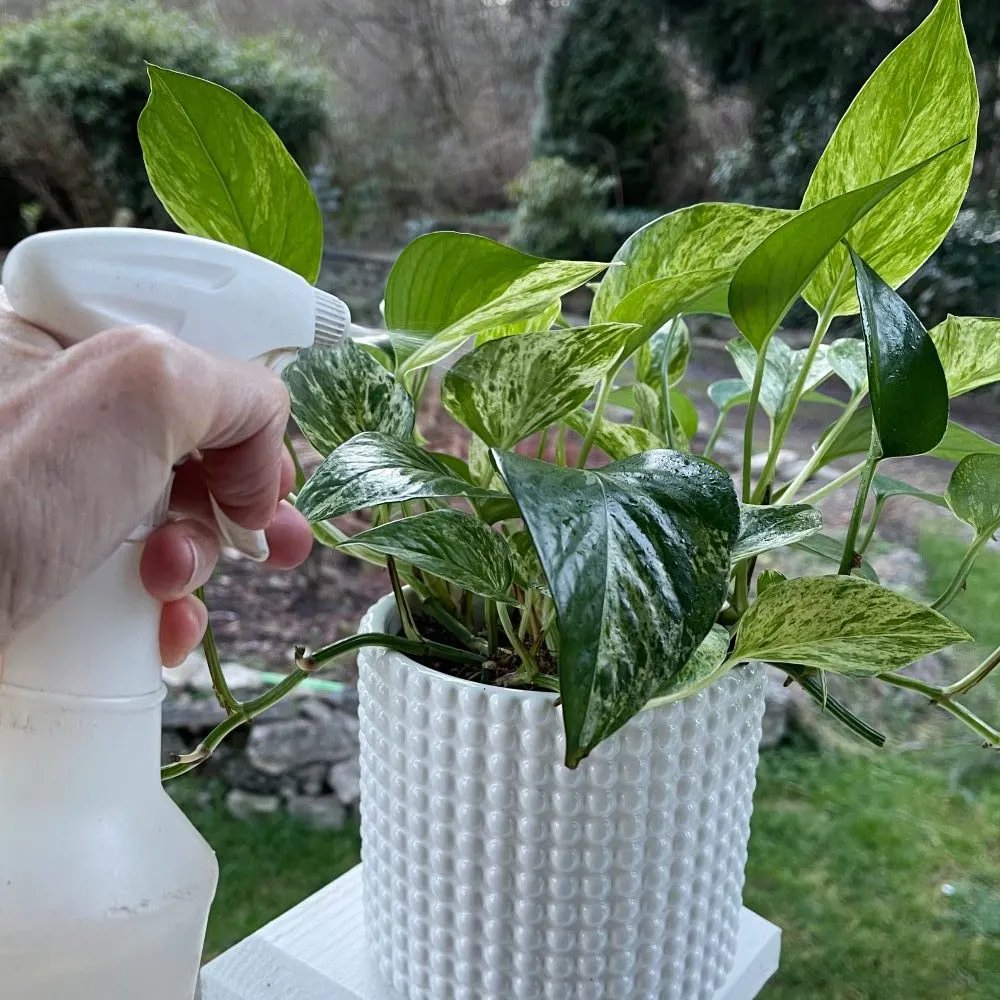
- To minimize the possibility of pests be sure to check all nursery plants before bringing them home. Carefully examine the top and bottom of the leaves.
- Do NOT purchase plants with signs of pest damage or disease.
- Quarantine all new plants until you are sure no pests live in them.
How to Propagate Calatheas:
- Propagation is best done through root division.
- Seed propagation can be done but the seeds can be difficult to source.
- Dividing a calathea is easiest when repotting it in spring or summer.
- Unpot the plant gently. Look at the root system. If the plant is mature you should see a natural parting in the leaves and roots. This is the two plants growing together.
- Gently pull the two parts to separate them. If the roots are heavily intertwined cut them as necessary with sharp sterile scissors or small pruners.
Pot the two plant sections in separate pots. In 2 to 4 weeks the divisions should be settled and growing.
Non Toxic Plant:
- All calatheas are non toxic to humans and pets. Still it not recommended to chew any houseplant.
- Biting or swatting are not good for the health of the plant.
- Also you don't know what chemicals or pathogens are in the soil or fertilizers you use. So best practice is to keep houseplants away from pets and kids.
Follow Us:
Find us on YouTube, Instagram , Pinterest and TikTok! We love to Plant chat. We also comment, like and occasionally share your content to our daily stories. We’d love to see your plants. Share your joy in your houseplants. Happy Planting!
- 5 Fantastic Cactus Species for Your Home
- Pygmy Date Palm Trees
- Bromeliad Care Guide and Profile
- Growing Gloxinia Plants in Your Home
- Staghorn Ferns Care and Maintenance
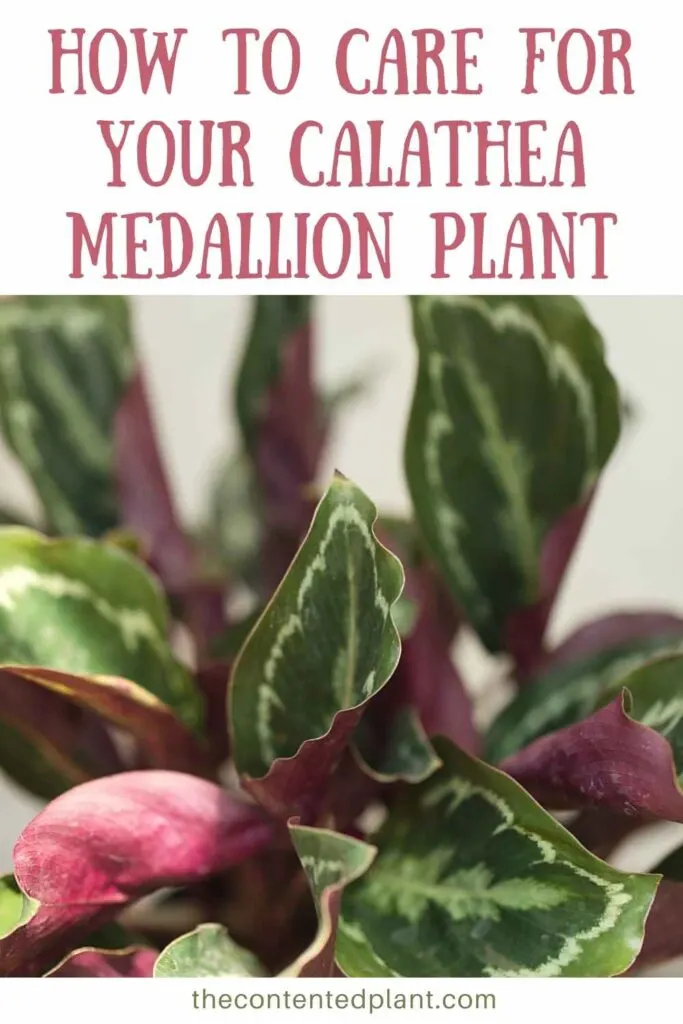

10 Plantas para Jardim de Inverno Incrível: Transforme Seu Lar
Tuesday 2nd of January 2024
[…] Calathea Medallion […]
Calathea Sanderiana: Pin-Strip, Prayer plant, Care
Tuesday 4th of July 2023
[…] Calathea Sanderiana ‘Medallion plant‘ […]
Lei
Wednesday 27th of October 2021
You say to let tap water sit overnight to allow chemicals to dissipate but further on you say to remedy an over concentration of salts, set the plant under a faucet of water for 10 mins. I’m confused what to do. Also, when repotting a root bound plant do I tease out the root ball?
Diane Williams
Wednesday 27th of October 2021
Hi Lei, Welcome the the contented plant. Thank you for your questions. We are always happy to help. :)
Answers to Your questions: 1:For the regular waterings. Letting the water sit overnight will evaporate off some common chemicals in your tap water. Calatheas are sensitive to chemicals, ph and minerals in your water. You can use distilled water also. I now use distilled water since my well water is much too hard and alkaline for calatheas.
2: This is about flushing the plant soil.Don't do this for regular waterings. The reason we need to do this is.The salts are caused by a concentration of fertilizer in the soil. Over Time those salts can build up the potting soil and cause your plant roots to burn. The solution to this is to thoroughly flush the salts out of the soil. You do this by pouring water through the roots until they are free of those salts. You can use tap water to do this if your tap water does not bother your calatheas. They tend to be sensitive. So if your tap water is hard and alkaline and high in minerals like mine, distilled water is best.
3:Teasing the root ball: Calatheas grow from a central rhizome and have small roots that grow out around the rhizome. When unpotting the calathea turn the pot gently upside down over a covered table and let the excess soil fall away. Now look at the root ball. Gently pull the small roots away from the rhizome. If they are tightly twined you can try to pull them apart for the repotting. You may have to do some root trimming with a sterile knife or scissors if the root ball is exceedingly tight.
I hope this helps! Happy Planting!
Alocasia Bambino Plant Care Guide and Profile - The Contented Plant
Thursday 9th of September 2021
[…] The Calathea Medallion f […]
Calathea Zebrina- The Zebra Plant - The Contented Plant
Friday 23rd of July 2021
[…] The Calathea Medallion […]